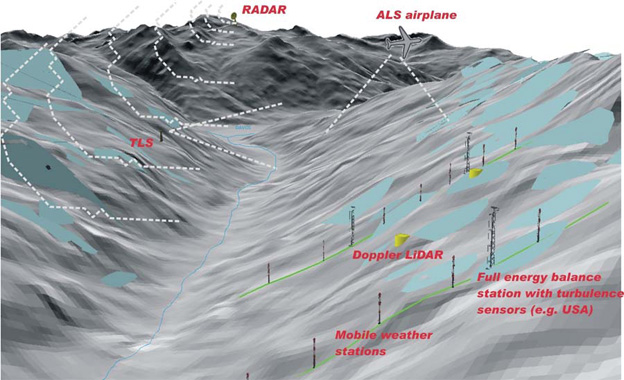This project investigates important processes driving snow deposition and ablation patterns on mountains. We apply process understanding at very small scales (1m) to larger scale (1km) behavior in a catchment. In particular, we aim to separate and quantify the effects of complex topography on cloud microphysics, and on the wind fields affecting snow deposition, in order to assess the relative importance of these processes in determining the distribution of the alpine snow cover. We also investigate how the complex interactions between topography, snow cover and the atmospheric boundary layer influence the melt dynamics.
Previous studies have shown that the three main processes are likely responsible for the observed differentiation in snow deposition, therefore we will focus the deposition part of this study on: (i) Orographically induced snowfall; (ii) Preferential deposition of precipitation caused by near-surface interaction of the mean and turbulent flow with snow particles; (iii) classical snow transport. Differences in snow ablation are mainly driven by local processes, which alter the energy balance. In this project, we focus on processes affecting the spatial distribution of snow during the ablation period: (i) snow accumulation in winter; (ii) spatial differences in shortwave and longwave radiation balances; (iii) atmospheric boundary layer processes such as local advection of sensible heat, boundary layer decoupling or slope-valley wind systems. The relative importance of processes affecting snow accumulation and ablation are investigated using a combination of experimental and numerical analyses. On the model side the study will be based on analyses using (i) the Weather Research and Forecasting (WRF-ARW) Model for modeling larger scale effects of mean flow characteristics and cloud microphysics; (ii) a combination of Lagrangian Stochastic Modeling (LSM) of particle dynamics with Large Eddy Simulation (LES) for smaller scale effects of boundary layer processes close to the ground and snow-particle interactions; (iii) the energy and snow cover process model Alpine3D to represent snow dynamics close to and at the ground. The model analyses will be complemented by airborne and terrestrial laser scanning surveys (ALS and TLS) of snow distribution on the ground, radar measurements of snow precipitation distribution and atmospheric measurements including eddy covariance measurement techniques, and – with the help of partner groups such as from EFLUM or the University of Utah – Doppler LIDAR, PIV systems and radiosondes in order to investigate the complex interaction between boundary layer flows and the snow cover on the very small scale (see Figure 1)

Overall, the project will lead to a better understanding and a quantitative description of snow cover accumulation and ablation dynamics in mountain regions. The main novelty of this research with respect to earlier investigations is the upscaling from small-scale process understanding to catchment scale prediction of accumulation and melt dynamics. The determination of the roles of the different small-scale processes will therefore help to better determine total amounts of snow precipitation and its vertical distribution in mountains worldwide and to better quantify the time development of the seasonal reservoir of snow in mountain catchments. This knowledge is vital for the prediction of future changes in the snow water resource under a changing climate.